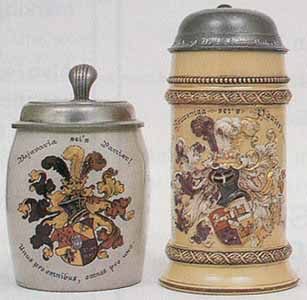
by Peter Meinlschmidt
Student steins are available in many varieties. Numerous types of decorations and materials have been used in the production of student steins. Students used practically every drinking vessel imaginable, and decorated them with their special symbols. Most student steins are decorated with the coats of arms of the studentsí associations and are provided with dedications for friends. Other steins bear only the symbol of the association, called the Zirkel.
 |
The coat of arms includes different symbols which indicate the town where the university is located (usually by means of a representative landmark) or the area of origin of the associationís members (such as the white and blue colors representing Bavaria). The names of the associations also reflected the place of origin of the members. For example, an association which included Bavaria in its name would have admitted primarily Bavarian people. These so-called compatriotic principles are no longer valid, as the associations have been admitting members from other areas since the middle of the 19th century.
The main symbols include beakers, an instrument known as a lyre (leier in German), the tree of life, and the snake. These symbols represent the pleasure of drinking, i.e., tippling, the pleasure of singing and the principle of lifelong membership. The Zirkel and colors of the studentsí associations, shown regularly in the helmet wisps of the coats of arms and in the helmet covers, indicate connection and their willingness to help and assist each other. Because of these sentiments, the necessity of mutual assistance, and the right to carry arms originating in the Middle Ages, the so-called fighting associations continue to carry their arms today at special occasions.
Most of the fighting associations, known as Mensuren, are indicated on student steins by two crossed sabers in the coat of arms, which are called Schlager in German. These call to mind the Mensurenís practice of fencing duels. Unlike the practice of dueling to the death, Mensuren duels were held for fun, with winning determined informally, based on performance rather than survival. All students in dueling associations had to participate in at least one duel.
It is generally very difficult to determine the association and the location of the university on student steins because there is no complete reference guide and the name and founding date are not always found on the stein. In these cases, one might learn more through old magazines or books, or by chance. Even if information such as the name of the owner, date of receipt (if a gift) or purchase, university name and where the student is from is available on the stein, it will sometimes not be possible to determine exactly which of the many associations are represented by the Zirkel on the stein.
In the past, there were about 4000 different associations accessible to German students at the universities of Germany, Austria, Switzerland, the Balkans, Czechoslovakia and other regions where they studied. Today, 1000 associations still exist, although many of them have closed or combined with others, and information about them is not readily available. A number of associations closed due to national prohibitions, and did not reopen after the prohibitions were dropped. This is true of the Jewish associations which never reopened after the end of the National Socialist dictatorship.
The government accepted these associations, with restrictions, because they had been democratically run from the start. Their leaders were elected for specific periods, and no important decisions were made without prior discussion. These democratic procedures were also in effect throughout the period of National Socialism, during which time the associations were forbidden but continued to function secretly. A well-known member of one of these associations was Count Schenk von Stauffenberg, a leading member of the resistance against Hitler.
I hope this information will aid other collectors of student steins, and I would appreciate any information the readers can share with me on this topic.
__________
*Reprinted from The Beer Stein Journal, February 1995, by permission from Gary Kirsner Auctions.